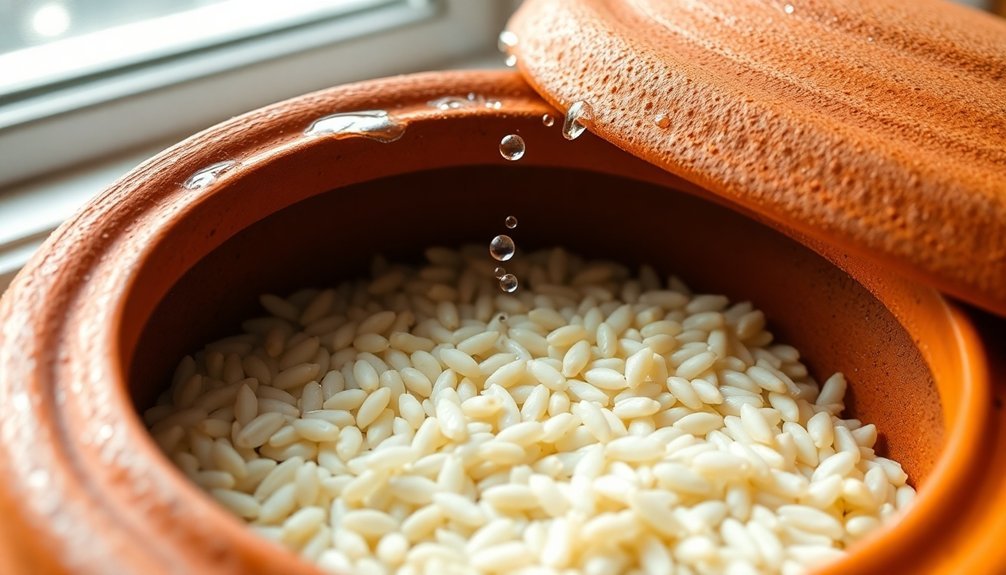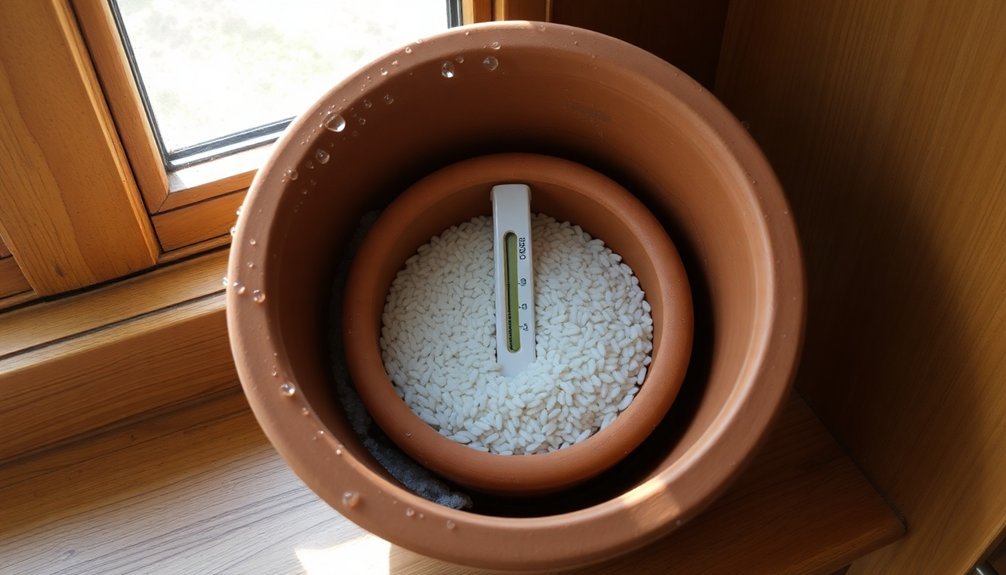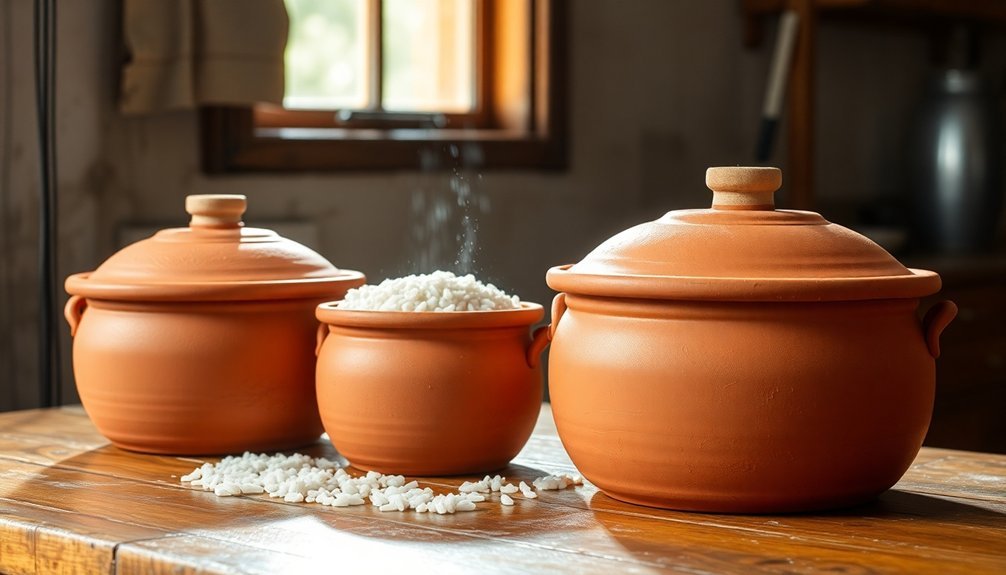Clay pots keep your rice fresh longer through three natural preservation methods. First, their porous structure regulates moisture perfectly, absorbing excess humidity while maintaining just enough for proper storage. Second, clay's mineral-rich composition transfers essential nutrients like calcium and magnesium into your rice, creating a stable environment that prevents nutrient loss. Third, these pots provide natural cooling through evaporation, lowering temperatures by up to 10°C and slowing down degradation. Unlike modern containers, clay pots work with nature to protect your rice's texture, flavor, and nutritional value – and that's just the beginning of their remarkable benefits.
Natural Moisture Control

Clay's remarkable porosity makes it the perfect material for controlling rice moisture during cooking and storage. When you cook rice in a clay pot, the porous nature of the material helps distribute and regulate moisture evenly throughout the cooking process.
You'll find that the clay naturally absorbs excess moisture while maintaining just the right amount of humidity inside the pot, preventing your rice from becoming either too dry or too wet.
You'll need to adjust your cooking technique based on your specific clay pot's porosity. If you're using a highly porous pot, you might need to add slightly more liquid than usual, as the clay will absorb some during cooking.
The pot's ability to heat slowly and evenly ensures your rice cooks consistently throughout. It's important to monitor the cooking process and add more liquid if needed to achieve perfectly cooked grains.
To prevent rice from sticking, you can add a small amount of oil or fat, which also helps create a desirable crispy bottom crust.
You'll find that proper seasoning of your clay pot enhances its non-stick properties. If rice does stick, simply soak the cooled pot in water for easy cleaning.
Essential Mineral Protection
Preserving essential minerals in your rice becomes effortless when using clay pots for storage and cooking. The natural clay material allows vital nutrients like calcium, iron, and magnesium to transfer into your food while maintaining a stable environment that prevents mineral loss during storage. The evaporative cooling effect helps regulate temperature and humidity levels for optimal mineral retention.
| Mineral Benefit | Clay Pot Advantage |
|---|---|
| Enhanced Nutrition | Porous clay transfers minerals to rice during cooking and storage |
| Natural Preservation | Creates dry, stable environment preventing nutrient degradation |
| Long-term Protection | Maintains milling quality and high germination rates |
You'll find that clay pots outperform commercial storage alternatives, especially when it comes to mineral preservation. Unlike metal or plastic containers that can react with food, clay pots provide a natural, inert environment that protects your rice's nutritional content. If you're looking to enhance the sealing properties, you can apply latex paint to your clay pot without compromising its mineral-transfer benefits.
For communities with limited access to modern storage solutions, clay pots offer a cost-effective way to maintain rice quality while providing additional nutritional benefits through mineral enrichment. This traditional storage method continues to prove its worth in preserving both food quality and vital nutrients.
Cool Temperature Storage

While clay pots excel at mineral preservation, their temperature-regulating properties make them even more valuable for rice storage. Through evaporative cooling, clay pots can reduce the temperature by up to 10°C below the surrounding environment, creating ideal conditions for preserving your rice's quality.
You'll find that clay pots work effectively by maintaining temperatures between 15-25°C (59-77°F), which considerably slows down moisture loss and lipid degradation in your rice. Freshly milled rice particularly benefits from this temperature control.
When you combine clay pots with wet sand and cloth covers, you'll enhance the cooling effect even further, helping to inhibit the physiological and biochemical reactions that cause rice aging.
To maximize your clay pot's cooling benefits, you'll want to place it in a shady, well-ventilated area away from heat sources like ovens and direct sunlight.
The pot's natural ability to regulate airflow and moisture levels creates a consistently cool and humid environment that extends your rice's shelf life.
You'll notice that this cooling effect, combined with the pot's moisture-regulating properties, helps maintain your rice's texture, freshness, and overall quality for extended periods.
Frequently Asked Questions
How Long Should Clay Pots Be Seasoned Before First Use With Rice?
You'll need to season your clay pot 3-5 times before cooking rice. Complete the water and flour mixture process each time, letting the pot cool between cycles. Don't rush this essential preparation.
Can Clay Pots Be Used Directly on Electric Stovetops?
No, you shouldn't use clay pots directly on electric stovetops. They can crack from thermal shock, won't activate pan detection sensors, and might melt under high heat. Use gas stoves or induction converters instead.
What Signs Indicate a Clay Pot Needs to Be Replaced?
You'll need to replace your clay pot when you notice severe cracks that leak, visible decay with flaking material, persistent water damage, or extensive wear and tear like deep discoloration and mold growth.
Does Rice Cooked in Clay Pots Require Different Water Proportions?
Yes, you'll need to adjust water ratios when cooking rice in clay pots. While some recipes suggest a 1:2 rice-to-water ratio, you can start with 1:1 and modify for your desired texture.
How Often Should Clay Pots Be Re-Sealed to Maintain Their Effectiveness?
You'll need to re-seal your clay pot based on its condition rather than a fixed schedule. Watch for signs like cracking or loss of non-stick properties, then re-season using ghee or coconut oil as needed.
In Summary
You'll find that clay pots offer an ideal traditional solution for keeping your rice fresh longer. Their natural moisture control, essential mineral protection, and cool temperature storage work together to preserve your rice's quality and flavor. By storing your rice in clay pots, you're not just choosing an eco-friendly option – you're also maintaining the grain's nutritional value and extending its shelf life.





Leave a Reply